A Comparison of Water Flooding and CO2-EOR Strategies for the Optimization of Oil Recovery: A Case Study of a Highly Heterogeneous Sandstone Formation
Abstract
:1. Introduction
2. Methodology
2.1. Technical Screening
2.2. Dynamic Simulation Modeling
2.2.1. Geological Model Construction
2.2.2. Fluid EOS Model Generation
2.3. Simulation Model Description
2.4. History Matching
2.5. Development Scenarios
2.6. Economic Analysis
2.7. Capital Expenditures
2.7.1. CO2 Recycling Plant
2.7.2. Production Facilities
2.7.3. Water Injection Facilities
2.7.4. CO2 Injection System
2.8. Operating Expenditures
3. Results and Discussion
3.1. Reservoir Characterization
3.2. Fluid Model
3.3. History Matching
3.4. EOR Scenarios
- (a)
- 15-year water flooding
- (b)
- 15-year continuous CO2 injection after 15-year water flooding
- Firstly, 3.0 MMSCFD is continuously injected through each well over a 15-year period, and the cumulative oil recovery is recorded at 59.7 MMSTB.
- Secondly, the bottom hole pressures (BHPs) of the injectors are constrained at 2700 psi, which is the minimum pressure to trigger the miscible condition of CO2 in reservoir fluid, to monitor the maximum required rate of CO2 injection and oil and water production (Figure 19). The total amount of oil is significantly recovered at 97 MMSTB (Figure 20). The CO2 volume, on the other hand, is initially injected at 8–10 MMSCFD into each well and peaks at 15–20 MMSCFD at the end of the operation. This continuous CO2 approach necessitates an aggregate of 8.52 million tons (Mt) (Table 6) to enhance oil recovery by 47 MMSTB. Even though the simulation reveals that 20% of CO2 can be recycled, the total purchased CO2 demands 6.83 million Mt.
- (c)
- 30-year water flooding
- (d)
- 15-year continuous CO2 injection after 30-year water flooding
- The daily injection rate of 3 MMSCF would improve oil mobility in the reservoir and reach the maximum exploitation of 76.1 MMSTB after 15 years. However, this process would only recycle 7% of the pumped CO2 gas and would require a CO2 procurement of 1.45 million Mt.
- In contrast, 2700 psi is conditioned as the maximum injection BHP, and the wells must inject gas at a rate ranging from 7 to 17.5 MMSCFD. By injecting a total of 10.3 million Mt CO2, the simulated result updates the cumulative oil recovery of 97.3 MMSTB (Figure 20), with the oil and water production rates shown in Figure 21. The gas recycling process can achieve 40% efficiency throughout the operation, but the CO2 purchase mass is estimated to be 6.19 million Mt.
- (e)
- 15-year water-alternating-gas (WAG) injection after 30-year water flooding
- 1:1 Cycle (water-first chasing): The process is designed to inject water and gas alternately every 12 months. After 15 years, a total mass of 1.95 million Mt CO2 is injected to accomplish 83.4 MMSTB for cumulative oil recovery. This 1:1 WAG cycle would bring 44% of the injected CO2 to the surface, requiring the operation to purchase 1.09 million Mt.
- 2:1 Cycle (water-first chasing): The process is tested to alternatively inject water for 16 months and gas for 8 months. Total oil production reaches an amount of 83.2 MMSTB, but the injected volume of CO2 is equivalent to 1.31 million Mt, which is less than 34% compared to the 1:1 cycle. This scenario involves a CO2 purchase of 0.78 million Mt.
- 3:1 Cycle (water-first chasing): The final water-first chasing scenario in the WAG test is performed for 18 months for water injection and 6 months for CO2 injection. The total amount of injected CO2 in the entire operation is reduced to 0.89 million Mt (Figure 23) (less than 54% of 1:1 cycle and 32% of 2:1 cycle), but the cumulative oil recovery remains at 83.2 MMSTB, with the oil and water production rates displayed in Figure 24. Furthermore, the recycled CO2 gas in this process is proportional to 38%, requiring a 0.55 million Mt CO2 purchase.
- 1:1 Cycle (gas-first chasing): The simulation is also activated for gas-first injection to evaluate and compare oil recovery and CO2 utilization efficiency. The chasing method still involves injecting gas and water alternately every 12 months. The result reveals that total oil production would peak at 83.3 MMSTB if 2.22 million Mt was injected, which is 12% higher compared to the 1:1 cycle of water-first injection.
3.5. Economic Analysis
4. Conclusions
Author Contributions
Funding
Data Availability Statement
Acknowledgments
Conflicts of Interest
References
- Energy, Office of Fossil Energy and Carbon Management; The U.S. Department of Energy. Enhanced Oil Recovery; Energy, Office of Fossil Energy and Carbon Management, The U.S. Department of Energy: Washington, DC, USA, 2023. [Google Scholar]
- Alfarge, D.; Wei, M.; Bai, B. Fundamentals of Enhanced Oil Recovery Methods for Unconventional Oil Reservoirs; Elsevier: Amsterdam, The Netherlands, 2020. [Google Scholar]
- Ren, B.; Duncan, I.J. Maximizing oil production from water alternating gas (CO2) injection into residual oil zones: The impact of oil saturation and heterogeneity. Energy 2021, 222, 119915. [Google Scholar] [CrossRef]
- Alvarado, V.; Manrique, E. Enhanced oil recovery: An update review. Energies 2010, 3, 1529–1575. [Google Scholar] [CrossRef]
- Bagrezaie, M.A.; Dabir, B.; Rashidi, F.; Moazzeni, A.R. Modeling of formation damage during smart water flooding in sandstone reservoirs. Sci. Rep. 2023, 13, 17564. [Google Scholar] [CrossRef] [PubMed]
- Jarrell, P.M.; Fox, C.E.; Stein, M.H.; Webb, S.L. Practical Aspects of CO2 Flooding; Society of Petroleum Engineers: Richardson, TX, USA, 2002. [Google Scholar]
- Verma, M.K. Fundamentals of Carbon Dioxide-Enhanced Oil Recovery (CO2-EOR): A Supporting Document of the Assessment Methodology for Hydrocarbon Recovery Using CO2-EOR Associated with Carbon Sequestration; US Geological Survey: Reston, VA, USA, 2015. [Google Scholar]
- Afzali, S.; Rezaei, N.; Zendehboudi, S. A comprehensive review on enhanced oil recovery by water alternating gas (WAG) injection. Fuel 2018, 227, 218–246. [Google Scholar] [CrossRef]
- Elsharafi, M. Literature review of water alternation gas injection. J. Earth Energy Eng. 2018, 7, 33–45. [Google Scholar]
- Abdullah, N.; Hasan, N. The implementation of Water Alternating (WAG) injection to obtain optimum recovery in Cornea Field, Australia. J. Pet. Explor. Prod. 2021, 11, 1475–1485. [Google Scholar] [CrossRef]
- Sadeghnejad, S.; Manteghian, M.; Ruzsaz, H. Simulation optimization of water-alternating-gas process under operational constraints: A case study in the Persian Gulf. Sci. Iran. 2019, 26, 3431–3446. [Google Scholar] [CrossRef]
- Touray, S. Effect of Water Alternating Gas Injection on ultimate Oil Recovery. Master’s Thesis, Engineering Dalhousie University, Halifax, NS, Canada, 2023. [Google Scholar]
- Rahimi, V.; Bidarigh, M.; Bahrami, P. Experimental study and performance investigation of miscible water-alternating-CO2 flooding for enhancing oil recovery in the Sarvak formation. Oil Gas Sci. Technol. Rev. D’ifp Energ. Nouv. 2017, 72, 35. [Google Scholar] [CrossRef]
- Zhou, D.; Yan, M.; Calvin, W.M. Optimization of a mature CO2 flood—From continuous injection to WAG. In Proceedings of the SPE Improved Oil Recovery Symposium, Tulsa, OK, USA, 14–18 April 2012. [Google Scholar]
- AlSeiari, R.A.M.; Bhushan, Y.; Igogo, A.; Singh, M.K.; Al Marzooqi, S.; Al Hammadi, S.A.; Khan, S.H.; Mohamed, M.A.; Brodie, J.; Al Tenaji, A.; et al. A success story of the first miscible CO2 WAG miscible WAG pilots in a giant carbonate reservoir in Abu Dhabi. In Proceedings of the ADIPEC, Abu Dhabi, United Arab Emirates, 31 October–3 November 2022. [Google Scholar]
- National Energy Technology Laboratory Carbon Dioxide Enhanced Oil Recovery; U.S. Department of Energy: Washington, DC, USA, 2010.
- McCoy, S.T. The Economics of CO2 Transport by Pipeline and Storage in Saline Aquifers and Oil Reservoirs; Department of Engineering and Public Policy: Pittsburgh, PA, USA, 2008. [Google Scholar]
- Kwak, D.H.; Kim, J.K. Techno-economic evaluation of CO2 enhanced oil recovery (EOR) with the optimization of CO2 supply. Int. J. Greenh. Gas Control 2017, 58, 169–184. [Google Scholar] [CrossRef]
- Heddle, G.; Herzog, H.; Klett, M. The Economics of CO2 Storage; Massachusetts Institute of Technology, Laboratory for Energy and the Environment: Cambridge, MA, USA, 2003. [Google Scholar]
- Ross-Coss, D.; Ampomah, W.; Cather, M.; Balch, R.S.; Mozley, P.; Rasmussen, L. An improved approach for sandstone reservoir characterization. In Proceedings of the SPE Western Regional Meeting, Anchorage, AK, USA, 23–26 May 2016. [Google Scholar]
- Koray, A.M.; Bui, D.; Kubi, E.A.; Ampomah, W.; Amosu, A. Machine Learning Based Reservoir Characterization and Numerical Modeling from Integrated Well Log and Core Data. Geoenergy Sci. Eng. 2024, 243, 213296. [Google Scholar] [CrossRef]
- Lu, H.; Xin, X.; Ye, J.; Yu, G. Analysis of factors impacting CO2 assisted gravity drainage in oil reservoirs with bottom water. Processes 2023, 11, 3290. [Google Scholar] [CrossRef]
- Koray, A.M.; Bui, D.; Ampomah, W.; Appiah Kubi, E.; Klumpenhower, J. Application of machine learning optimization workflow to improve oil recovery. In Proceedings of the SPE Oklahoma City Oil and Gas Symposium/Production and Operations Symposium, Oklahoma City, OK, USA, 17–19 April 2023. [Google Scholar]
- Gunda, D.; Ampomah, W.; Grigg, R.; Balch, R. Reservoir Fluid Characterization for Miscible Enhanced Oil Recovery. In Proceedings of the Carbon Management Technology Conference, Sugar Land, TX, USA, 17–19 November 2015. [Google Scholar]
- McCain, W., Jr. The Properties of Petroleum Fluids, 2nd ed.; PennWell Books: Tulsa, OK, USA, 1990. [Google Scholar]
- Whitson, C.H.; Brulé, M.R. Phase Behavior; Society of Petroleum Engineers: Richardson, TX, USA, 2000. [Google Scholar]
- Danesh, A. PVT and Phase Behaviour of Petroleum Reservoir Fluids; Elsevier: Amsterdam, The Netherlands, 1998. [Google Scholar]
- Whitson, C.H.; Sunjerga, S. PVT in Liquid-Rich Shale Reservoirs. In Proceedings of the SPE Annual Technical Conference and Exhibition, San Antonio, TX, USA, 8–10 October 2012. [Google Scholar]
- Bui, D.; Nguyen, T.; Yoo, H. A Coupled Geomechanics-Reservoir Simulation Workflow to Estimate the Optimal Well-Spacing in the Wolfcamp Formation in Lea County. In Proceedings of the AADE National Technical Conference and Exhibition, Midland, TX, USA, 4–5 April 2023. [Google Scholar]
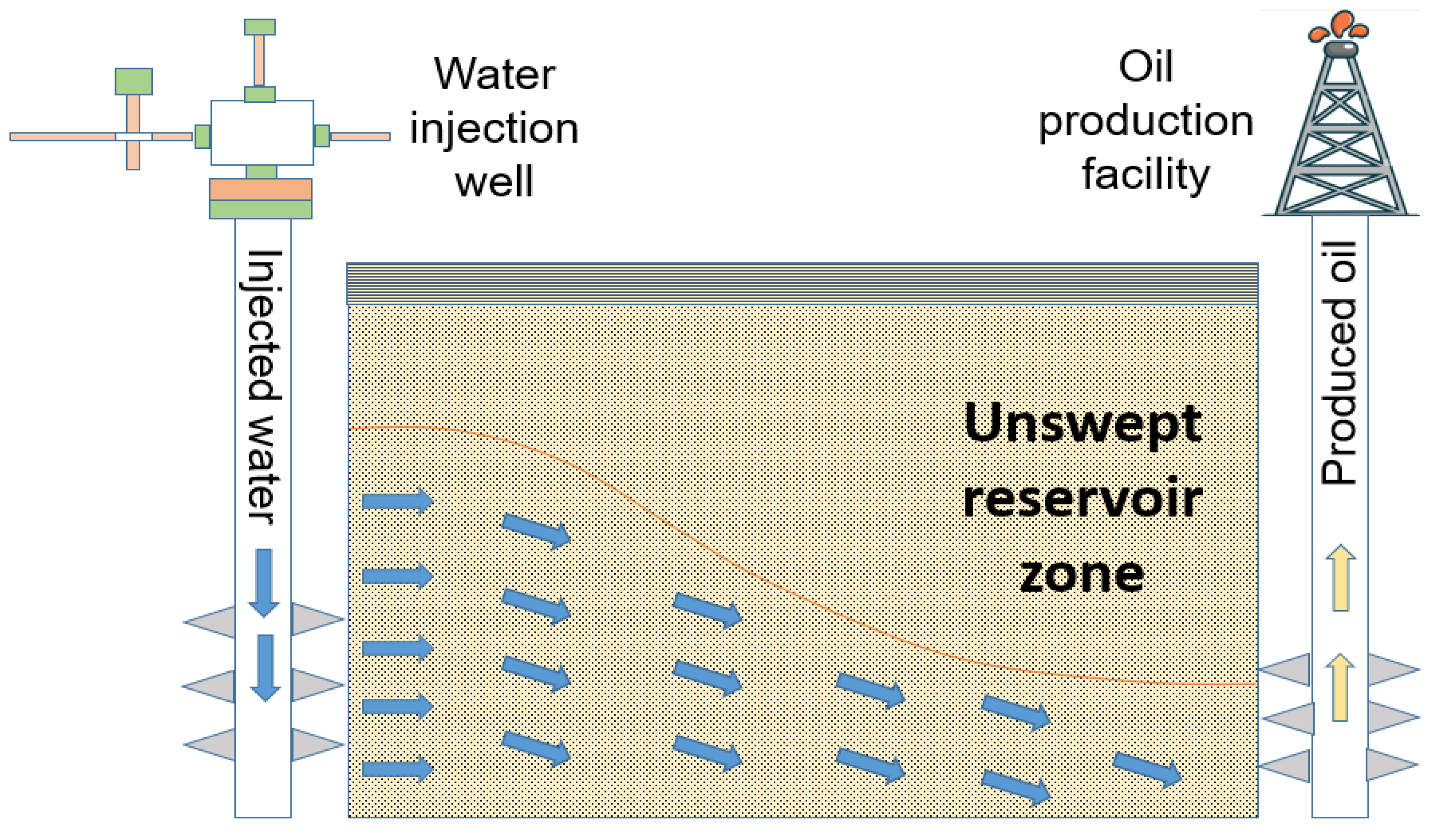
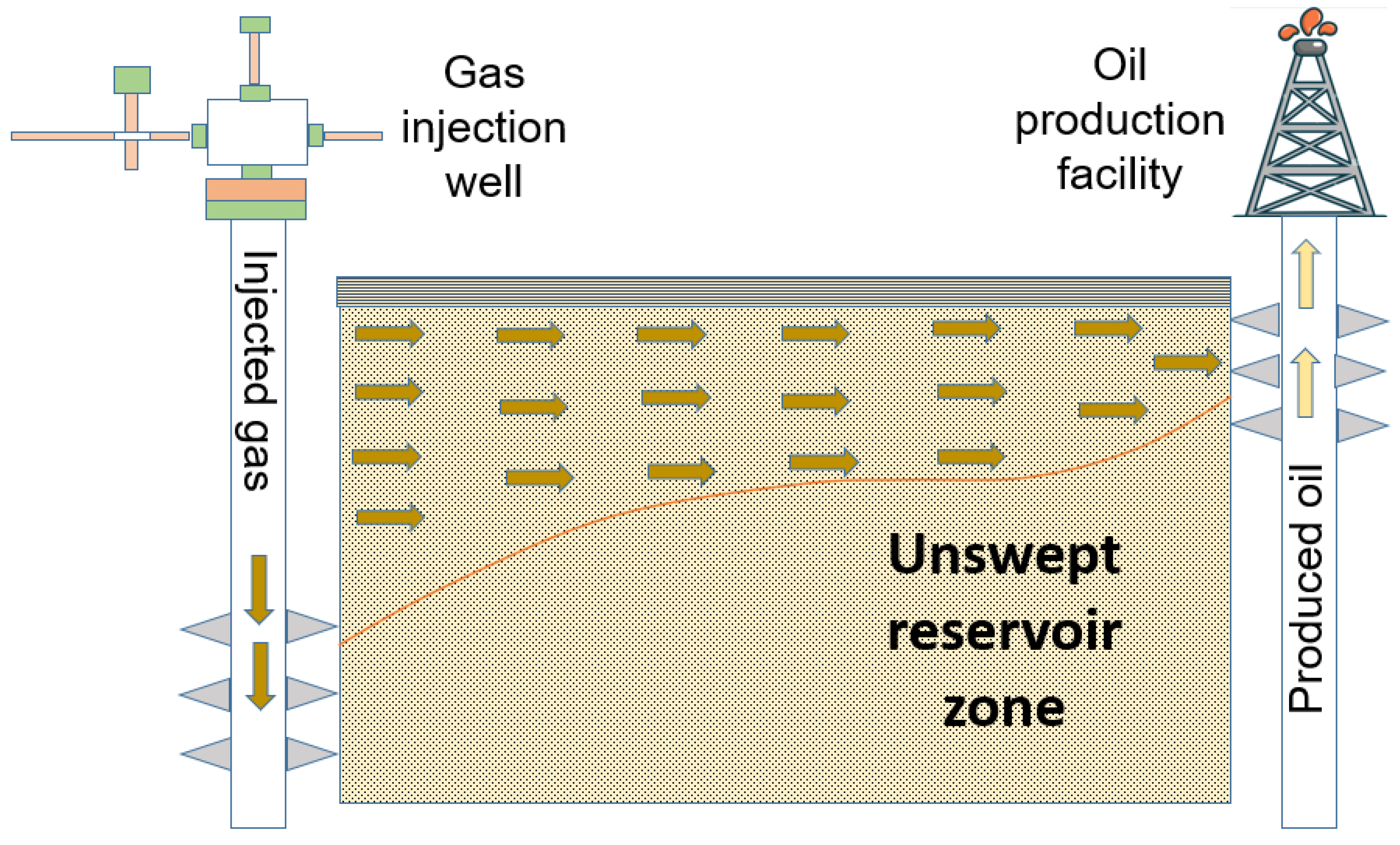
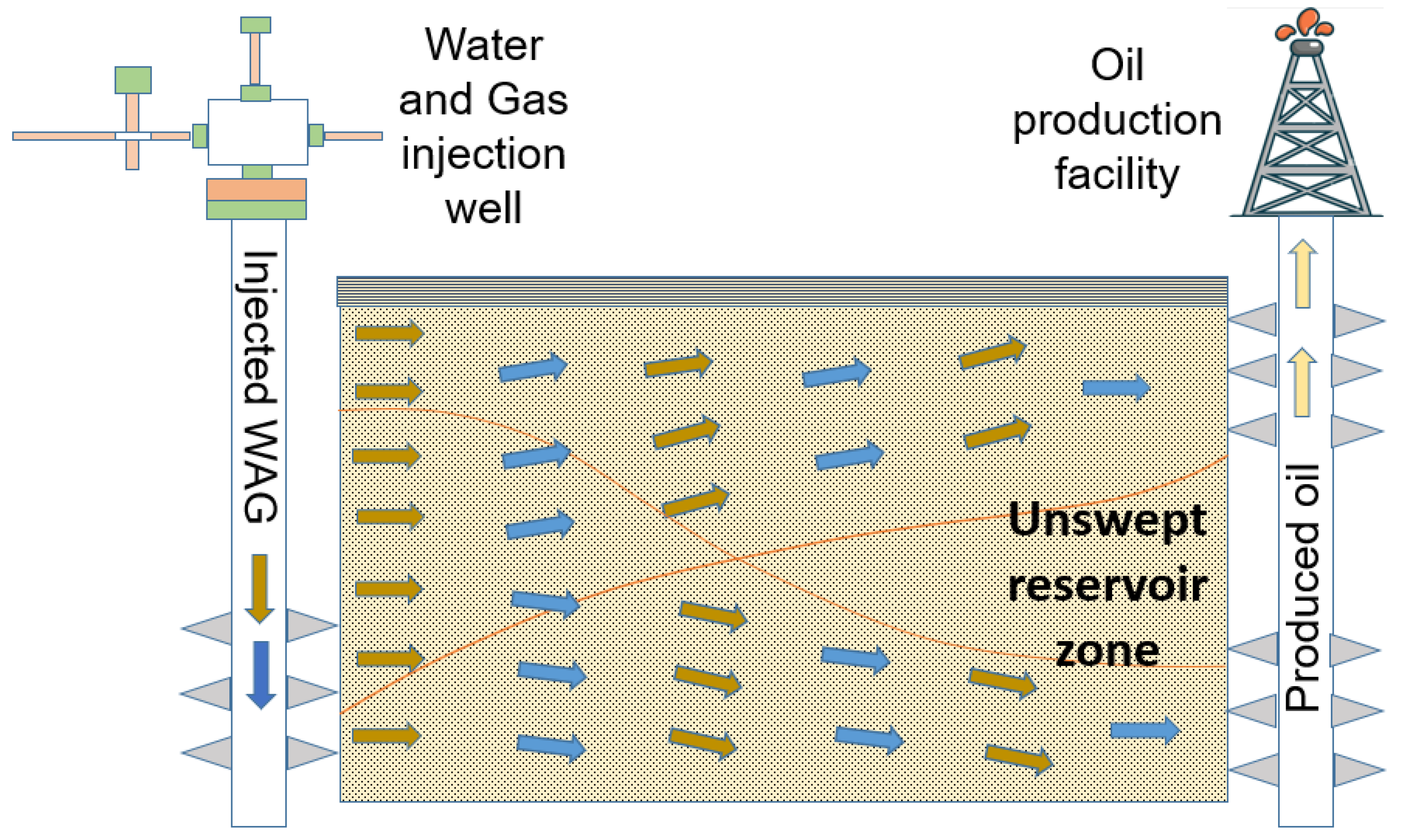
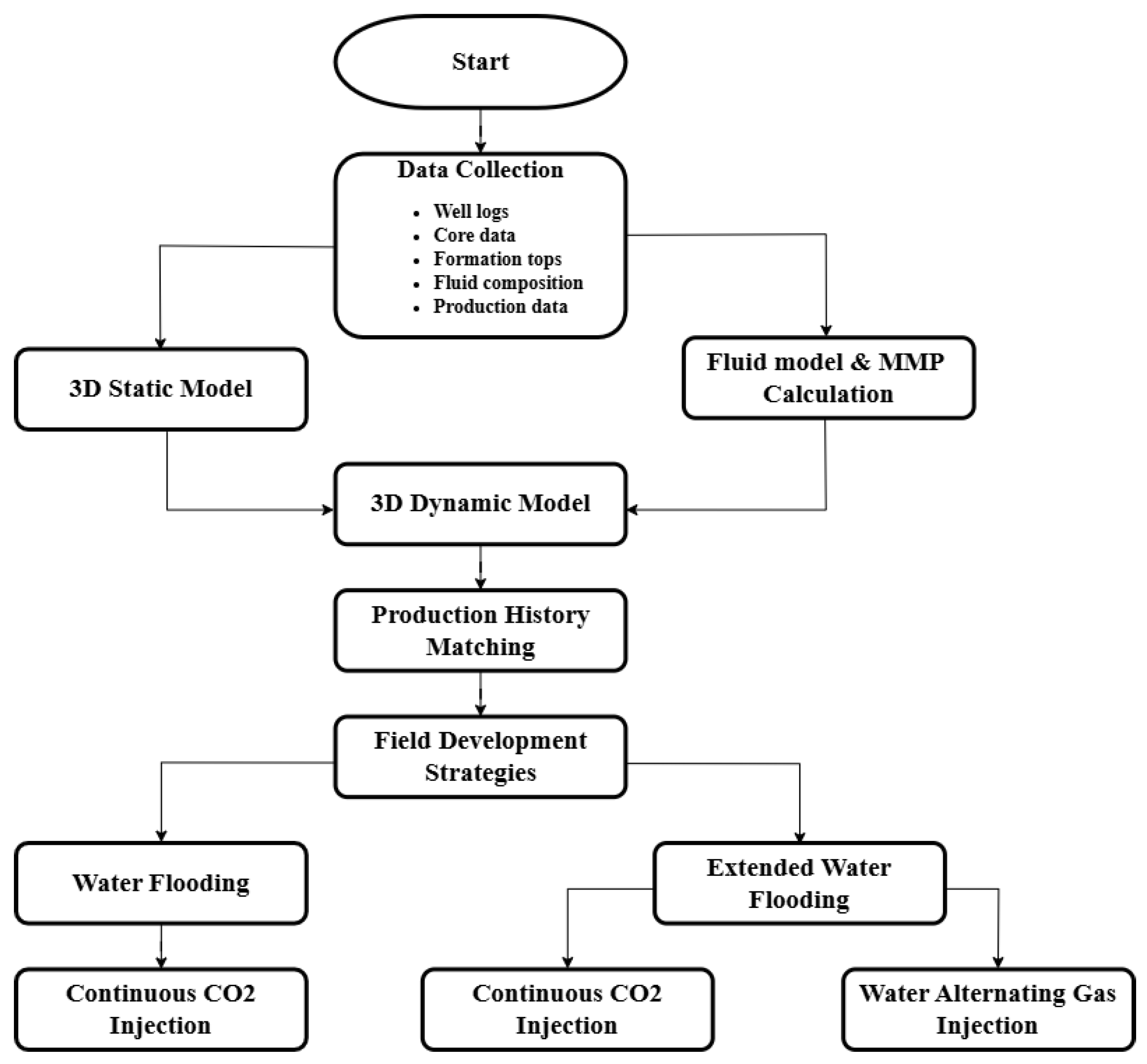
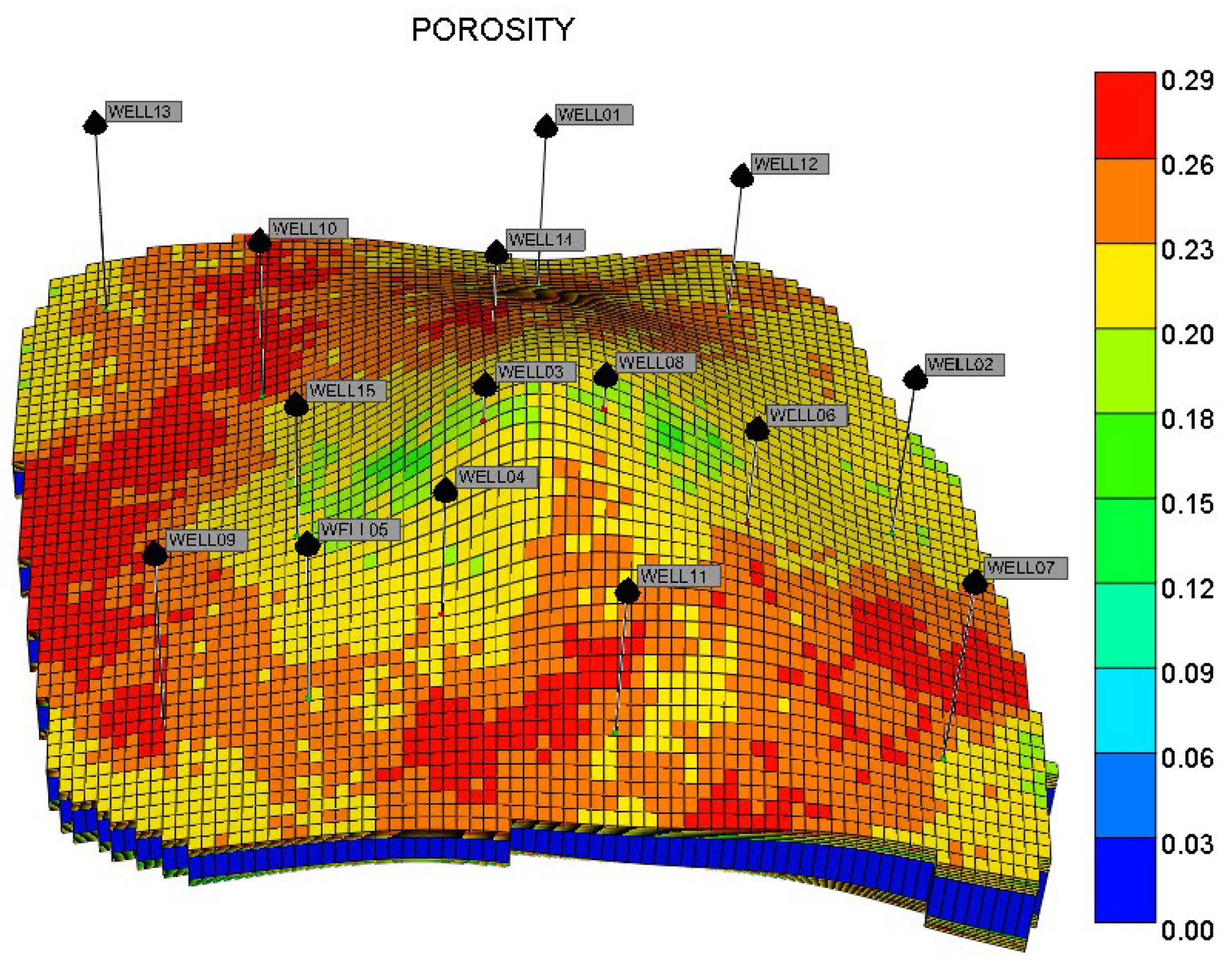
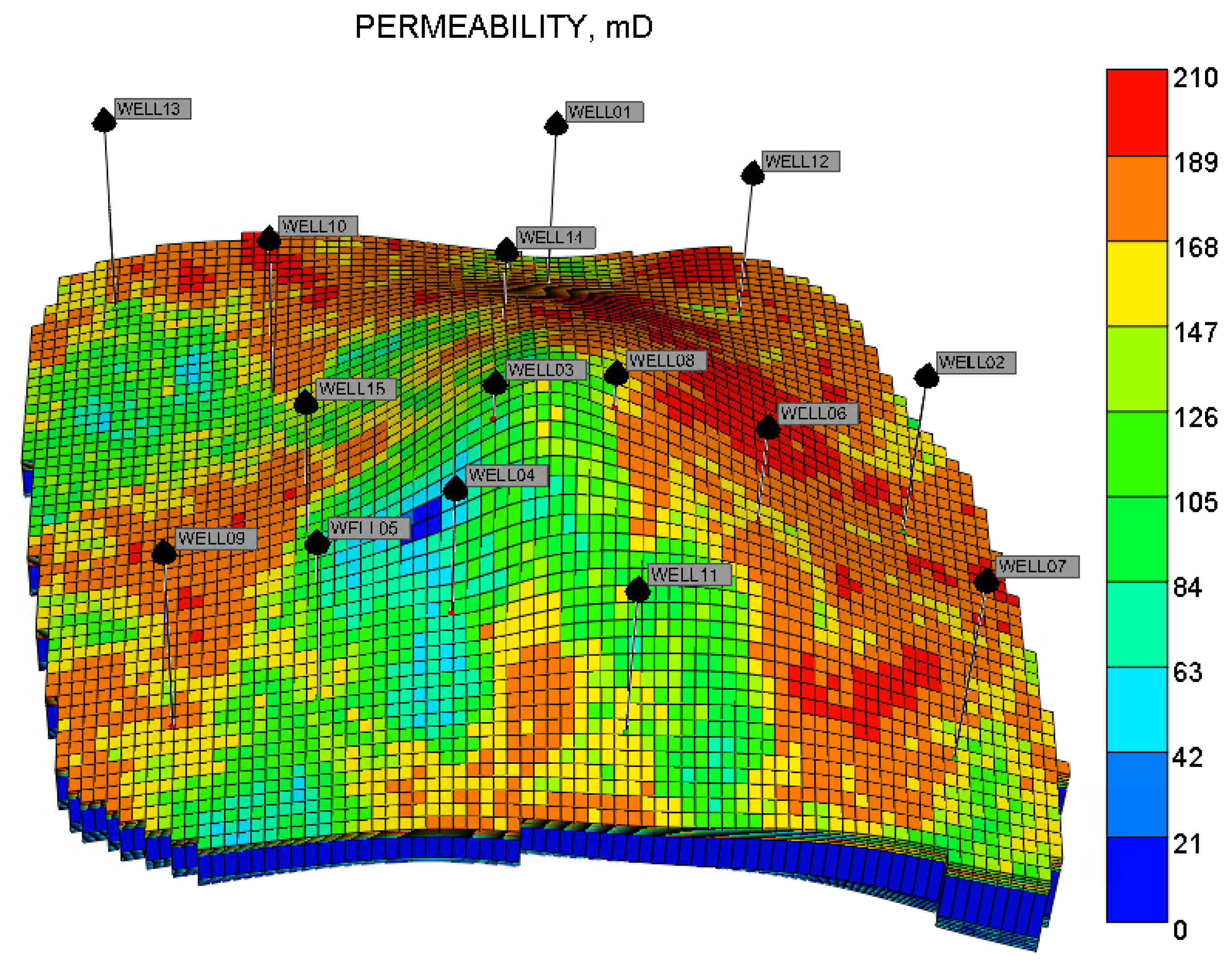
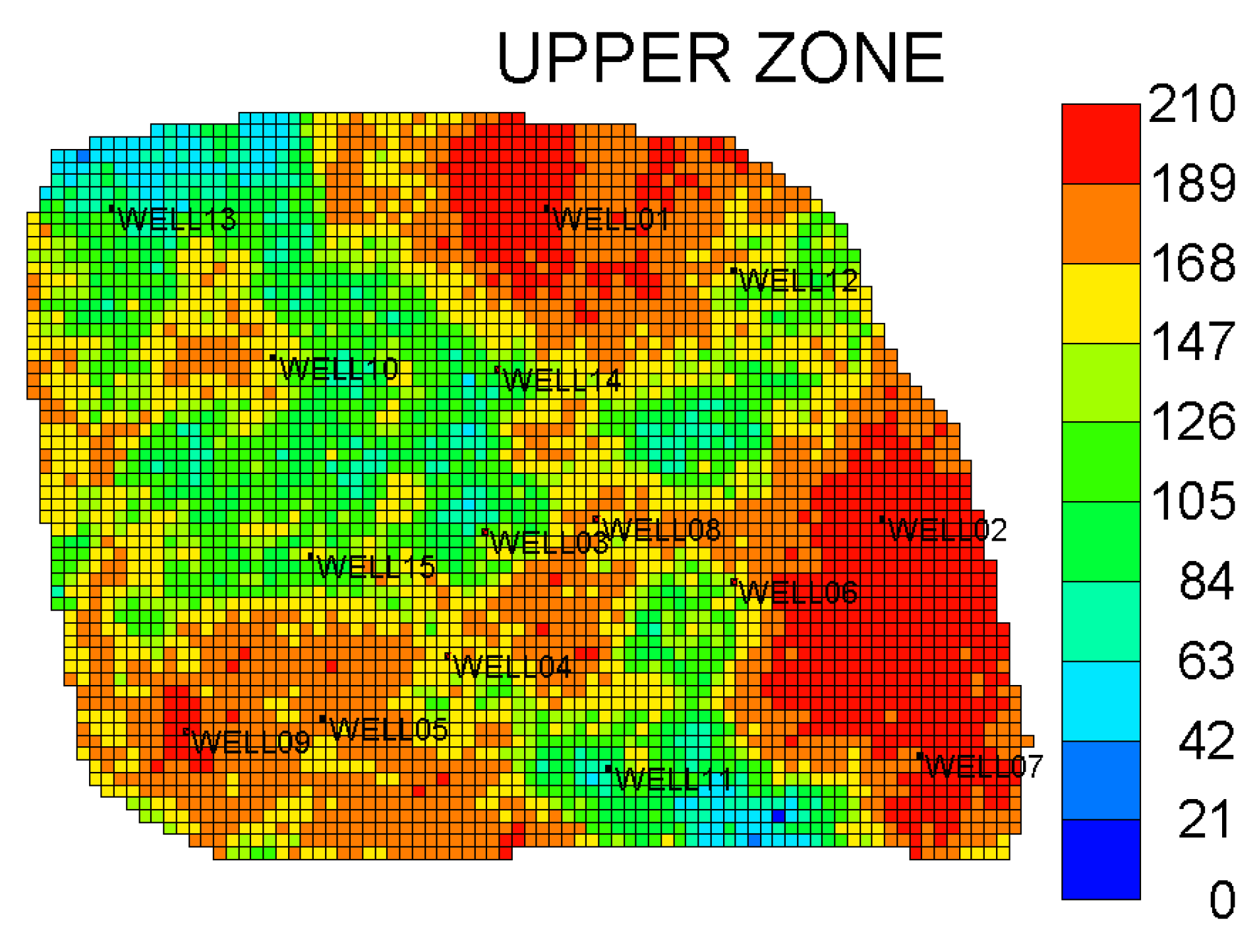
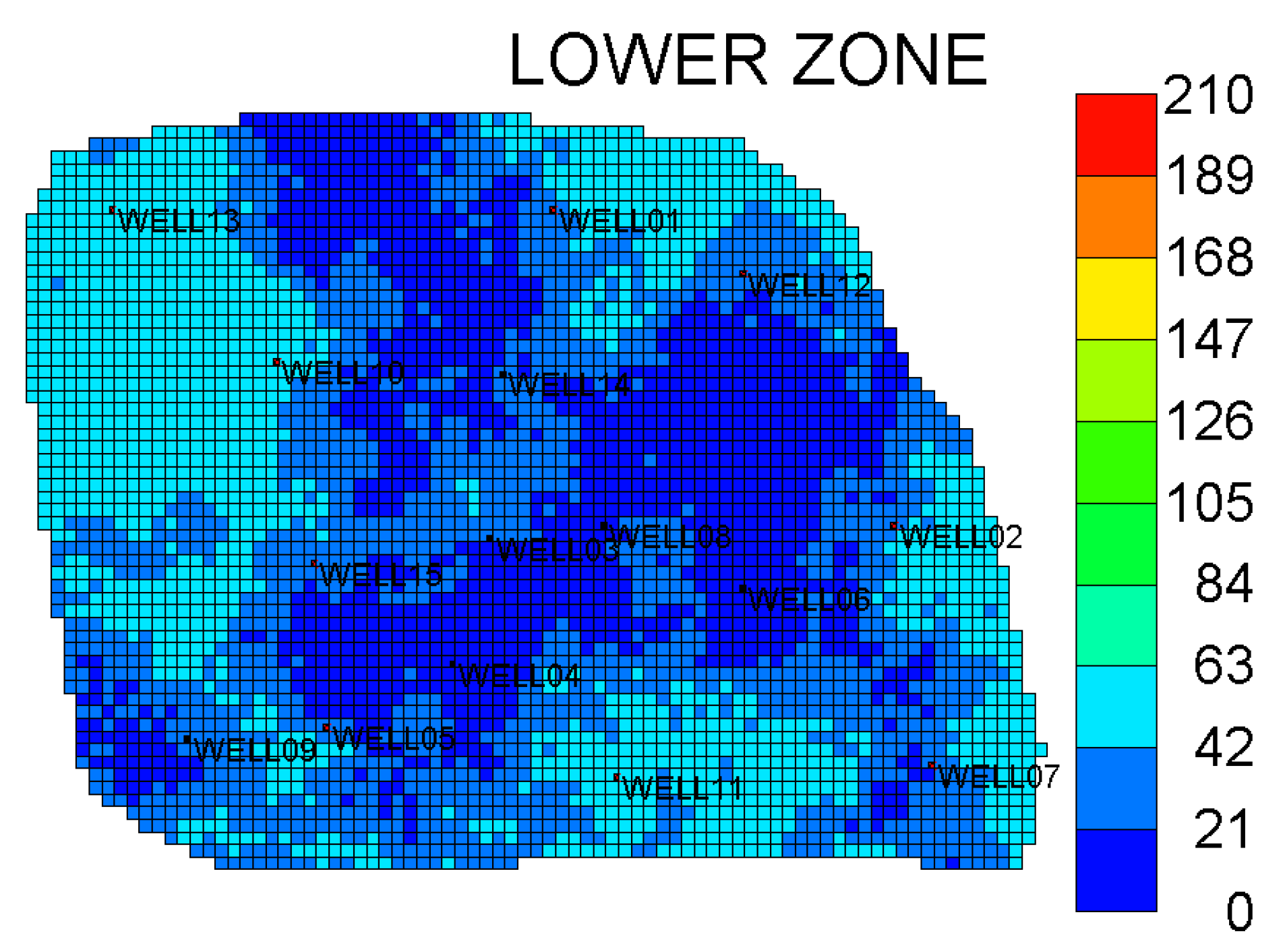
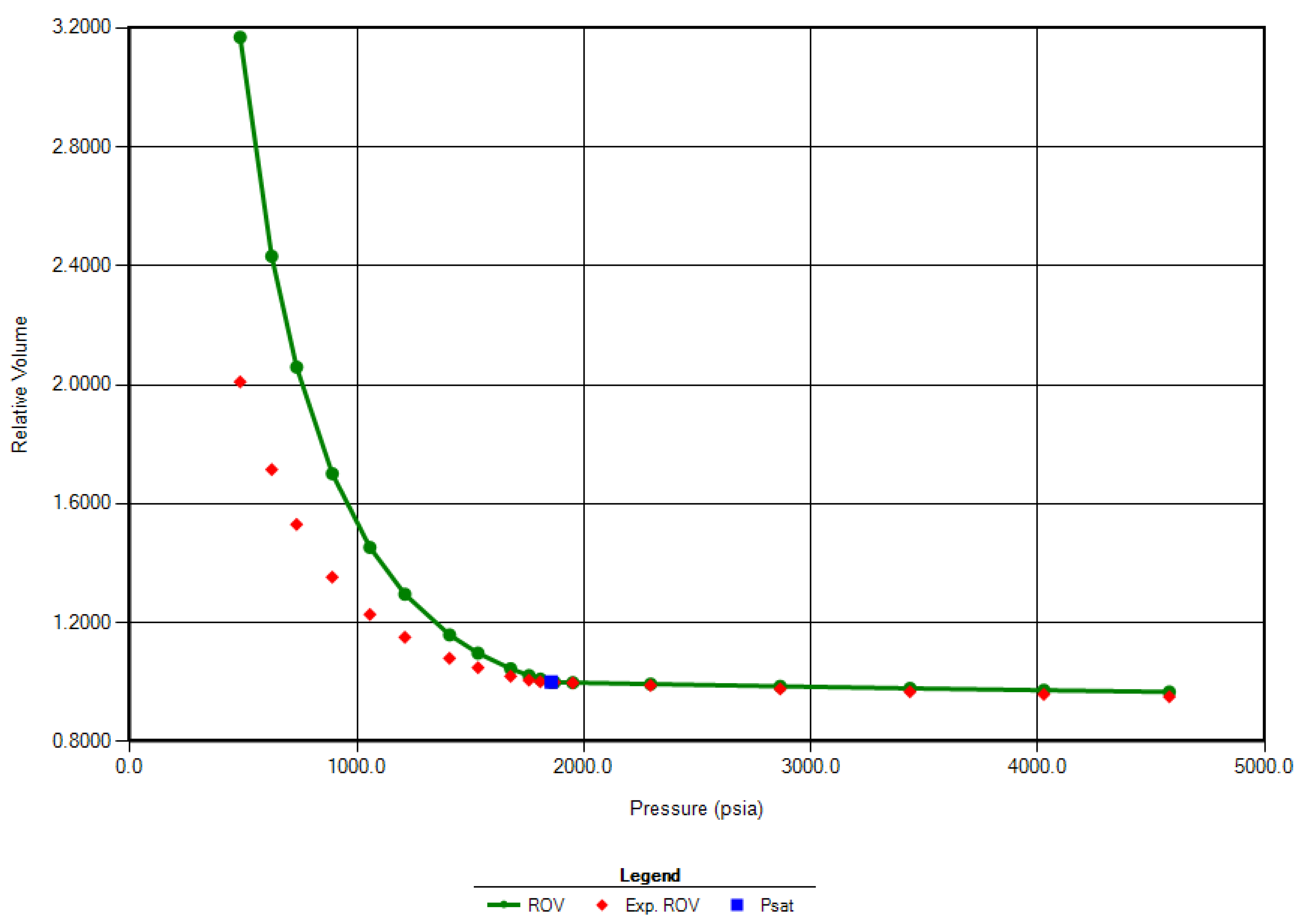
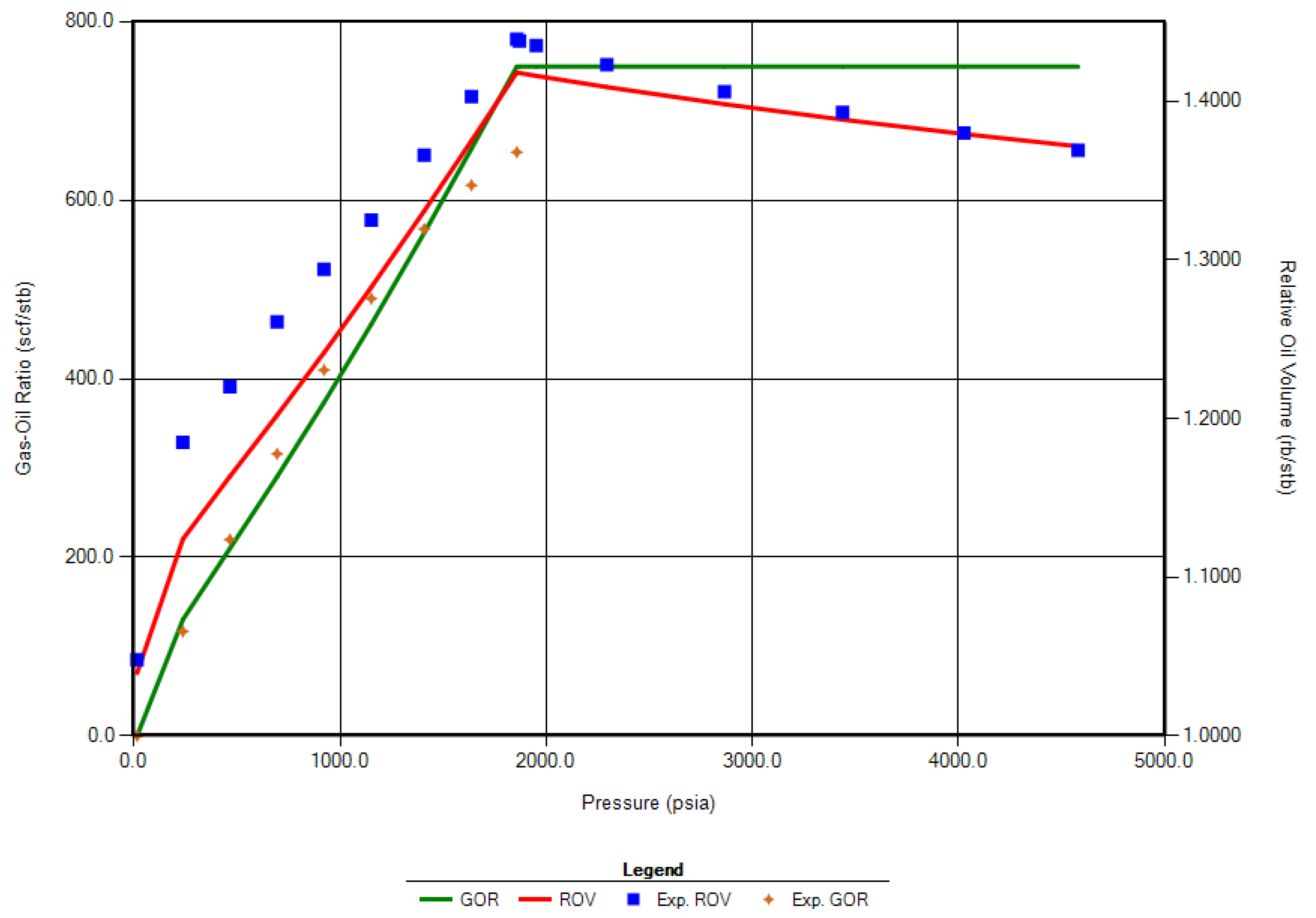
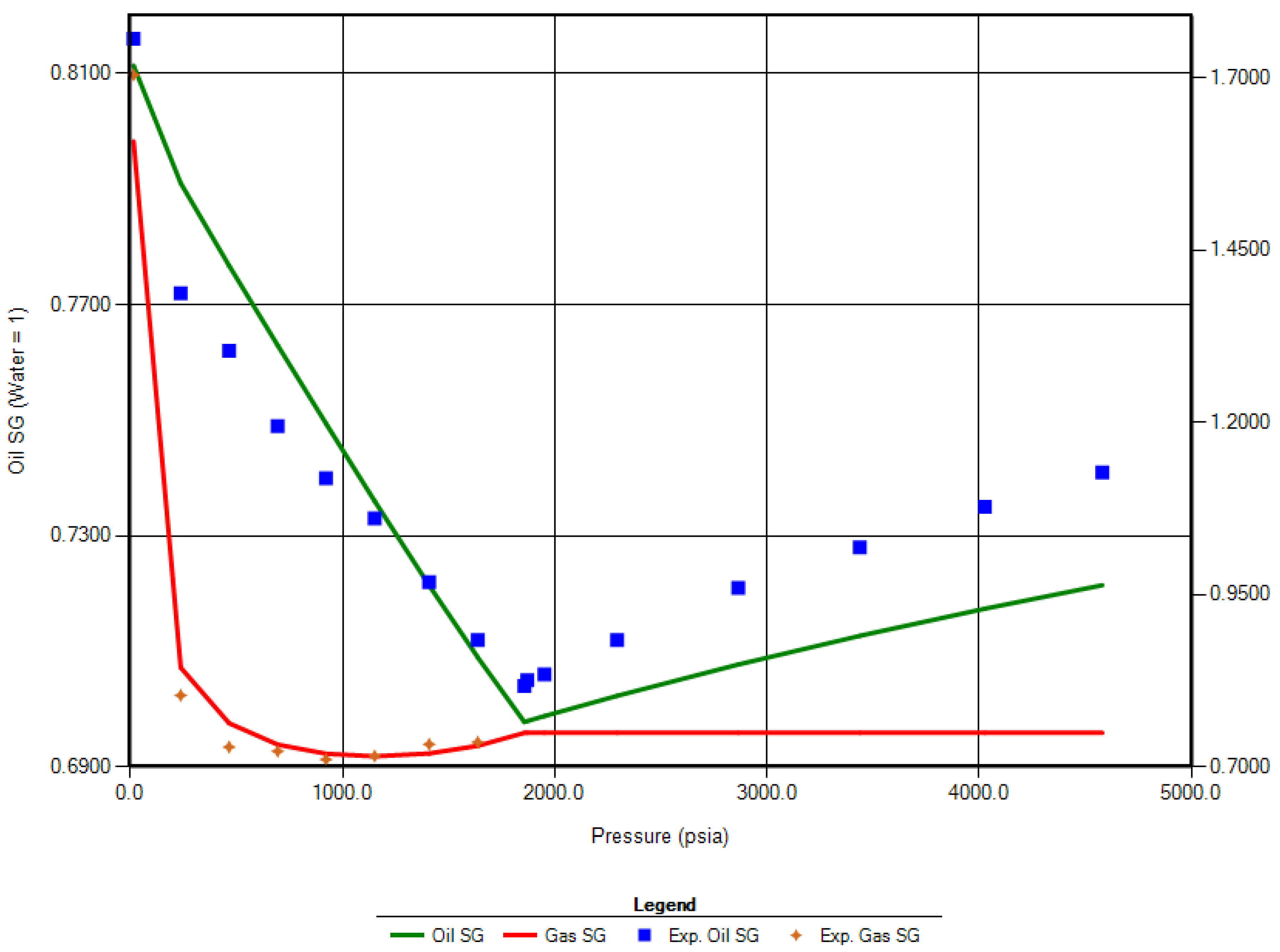
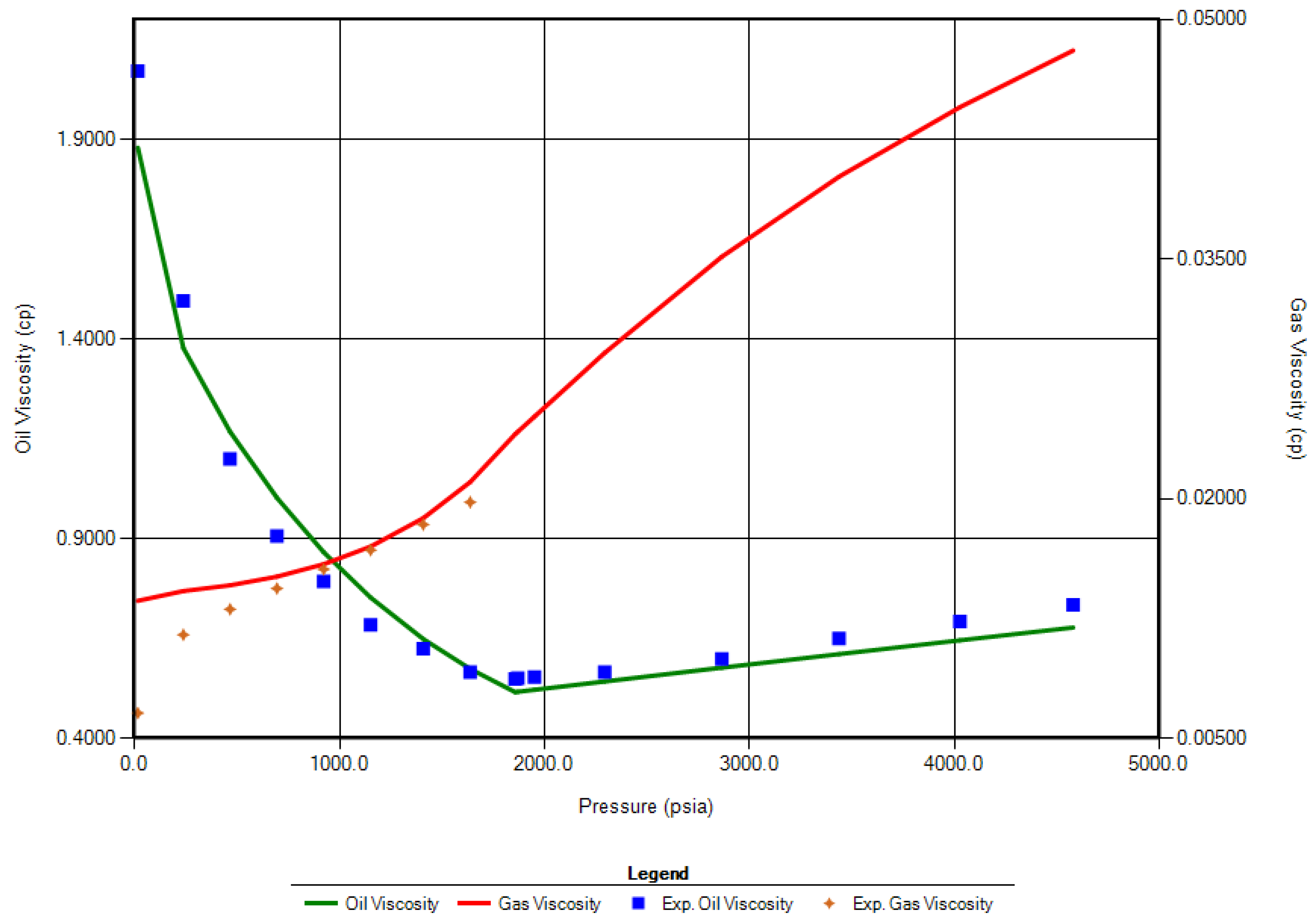

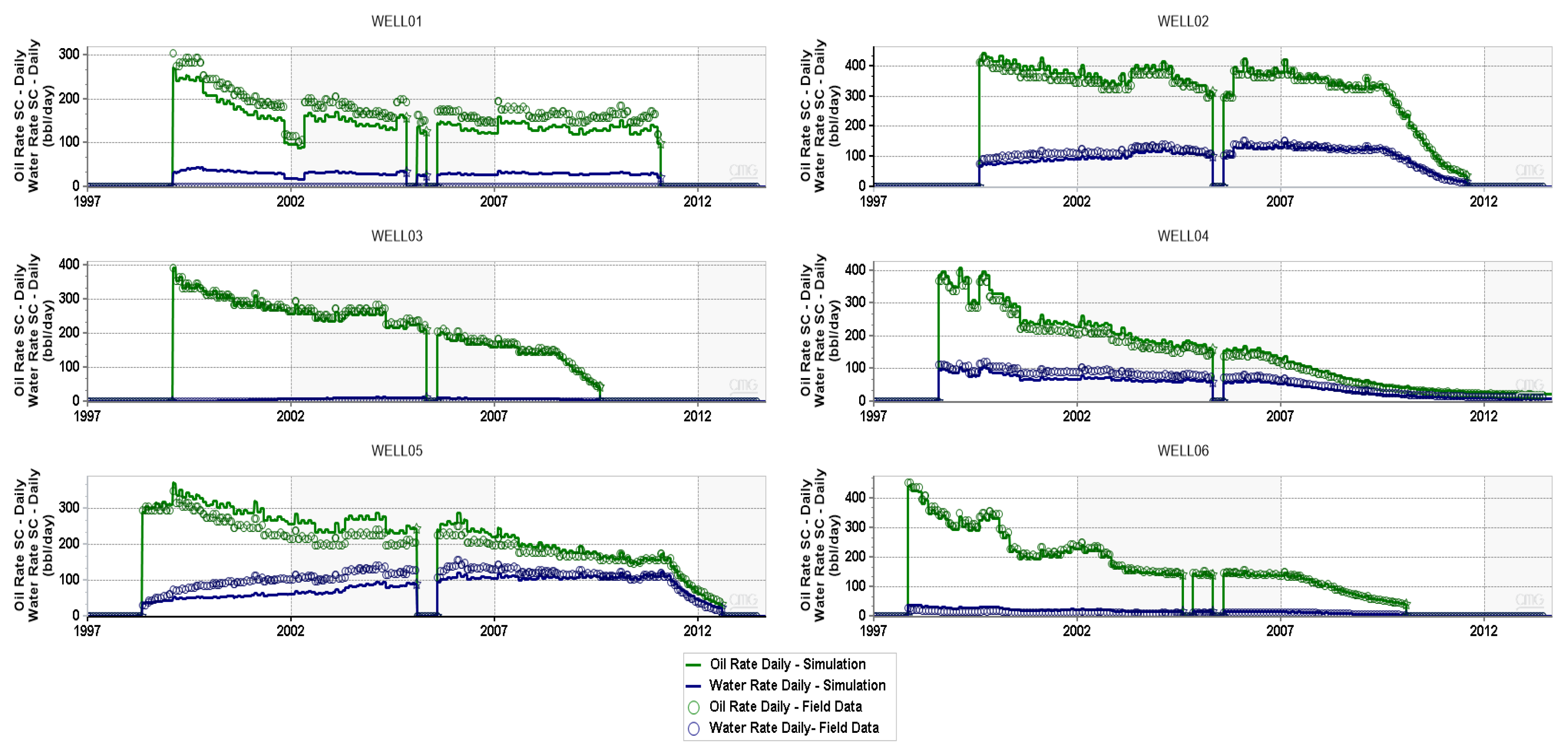
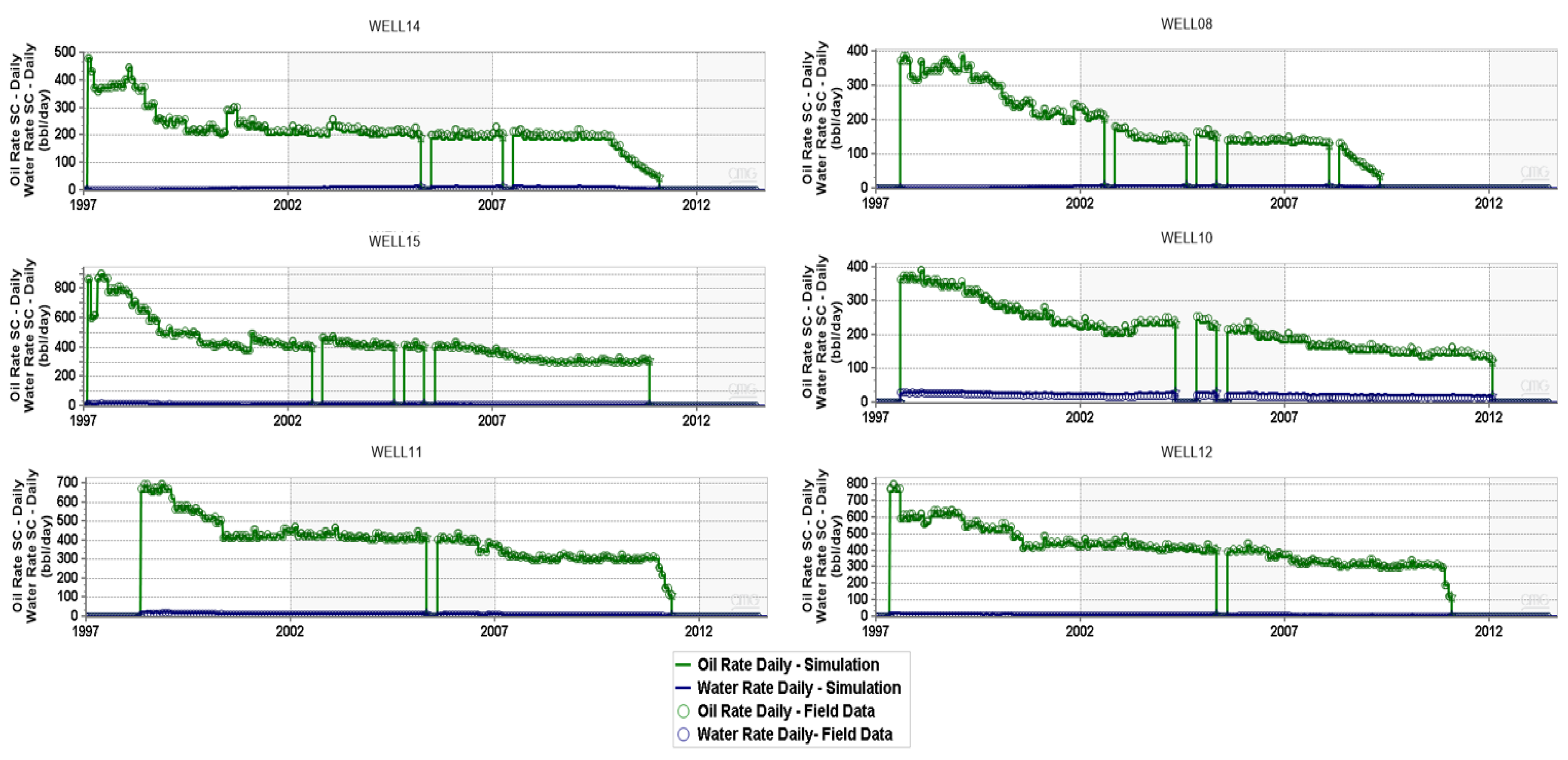

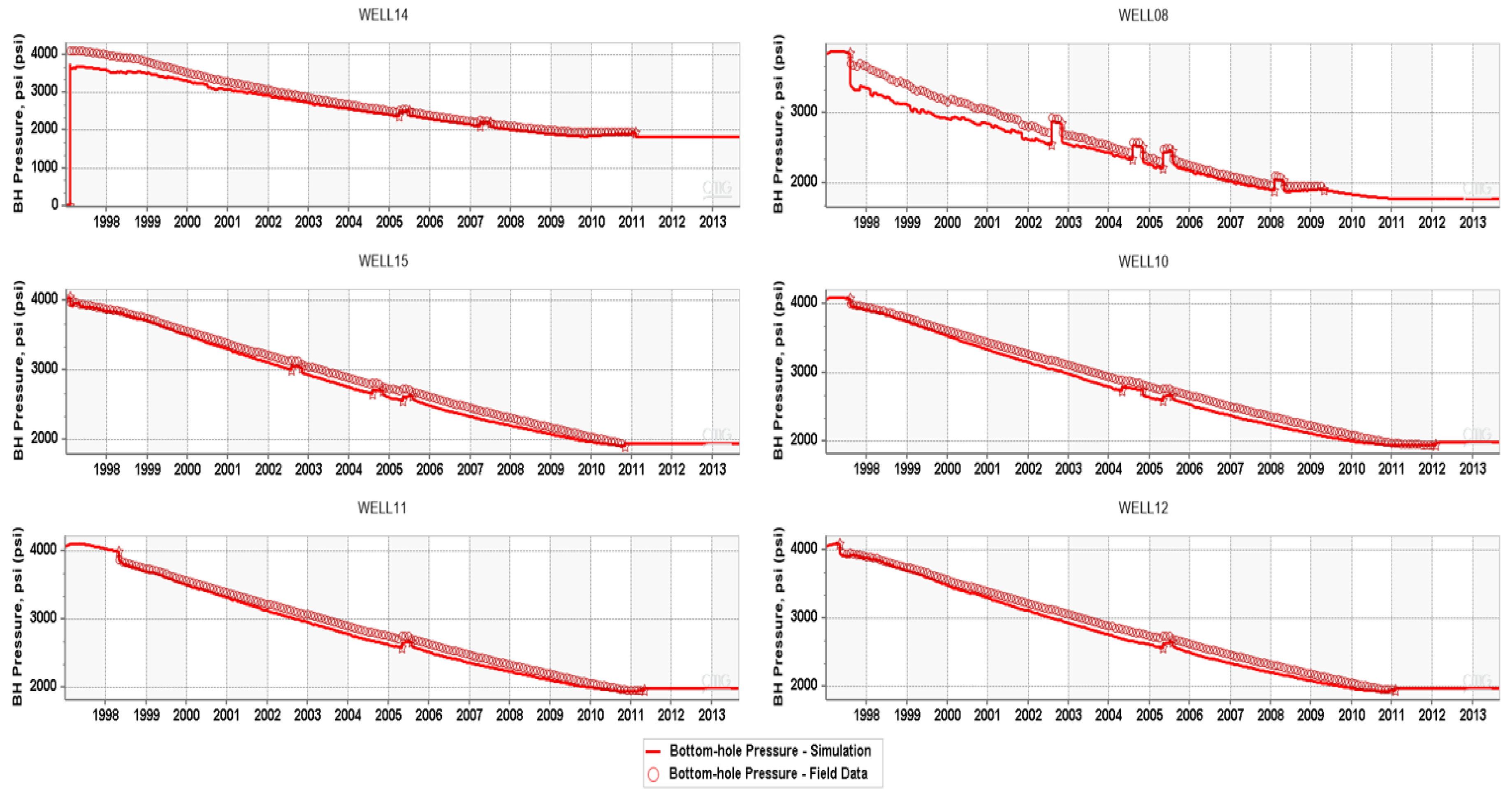
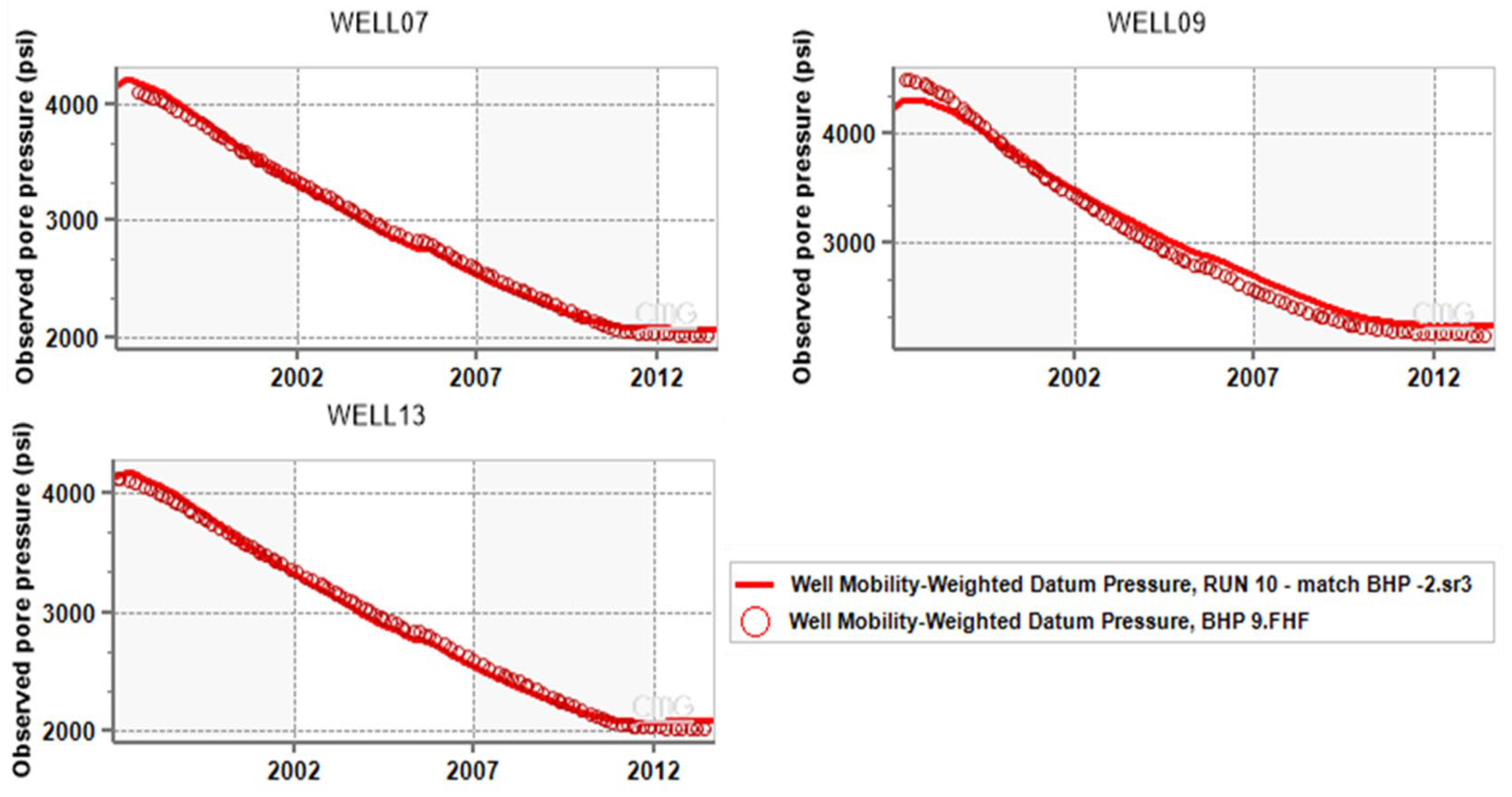

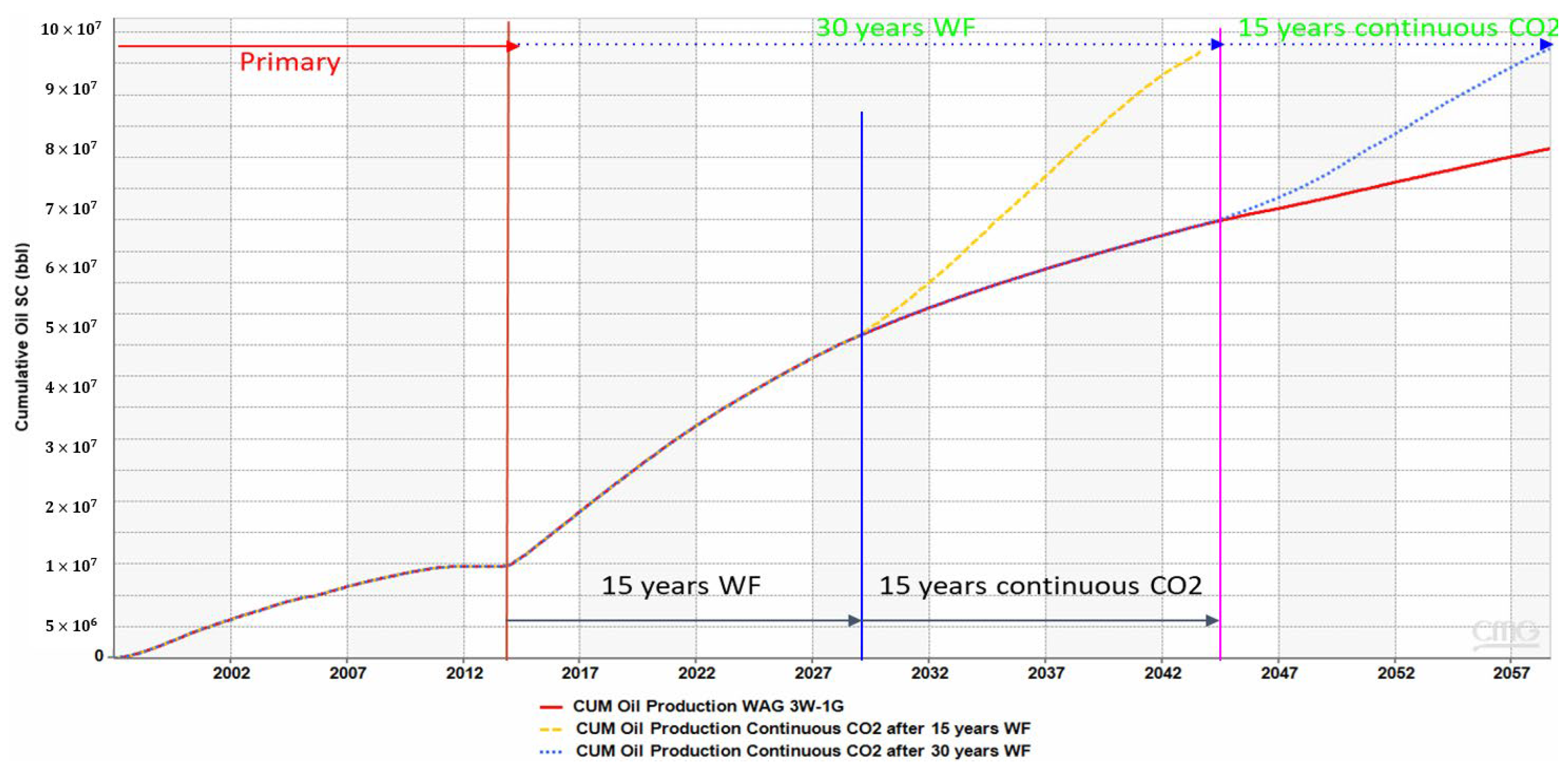
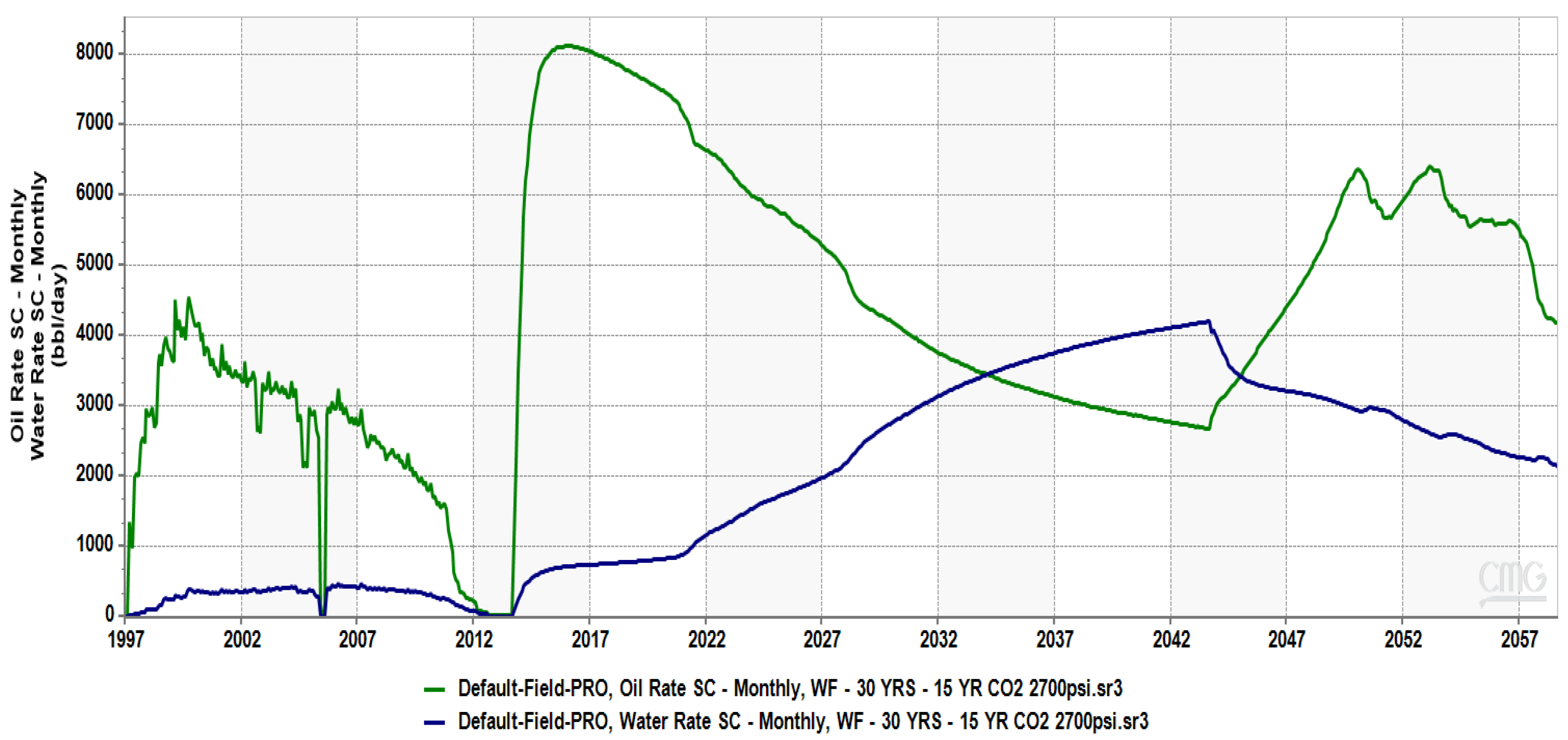

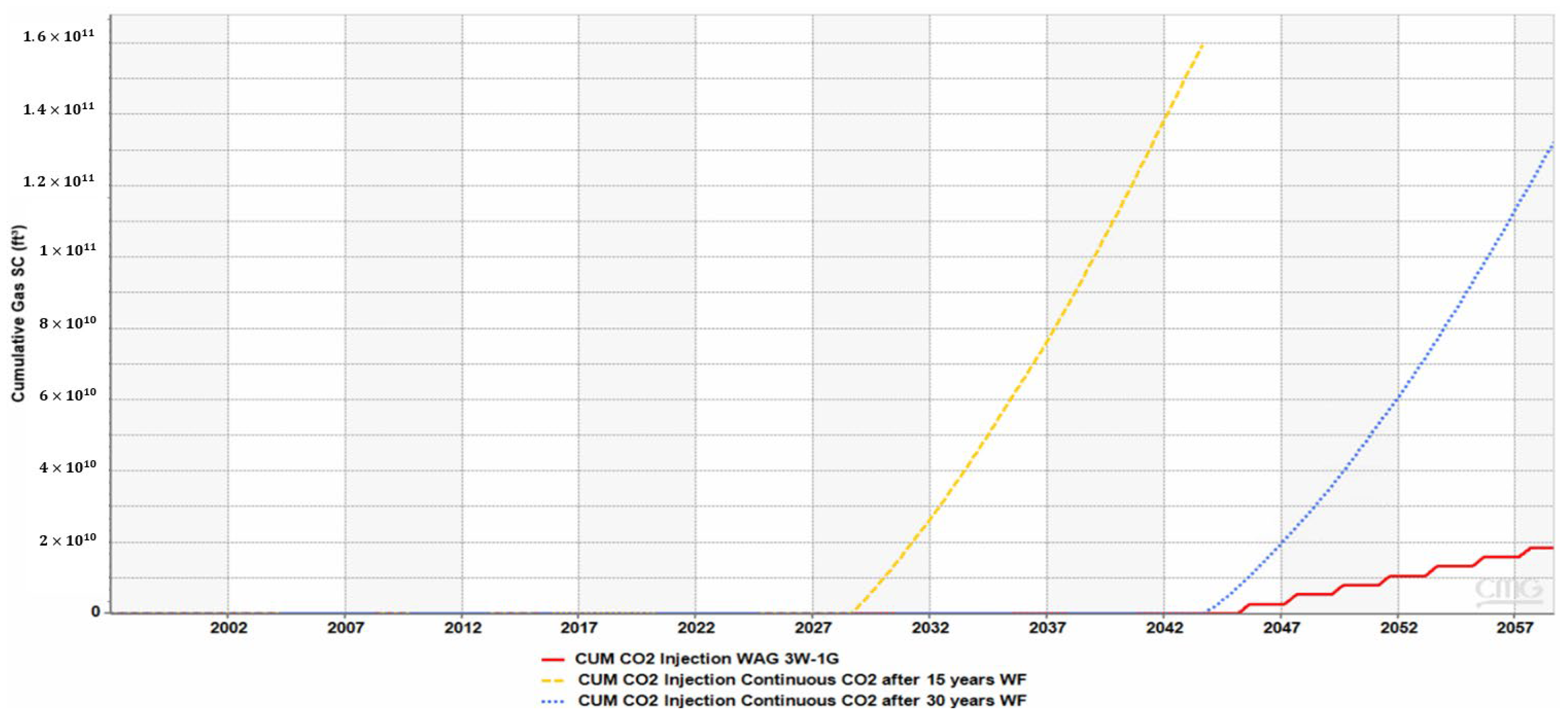
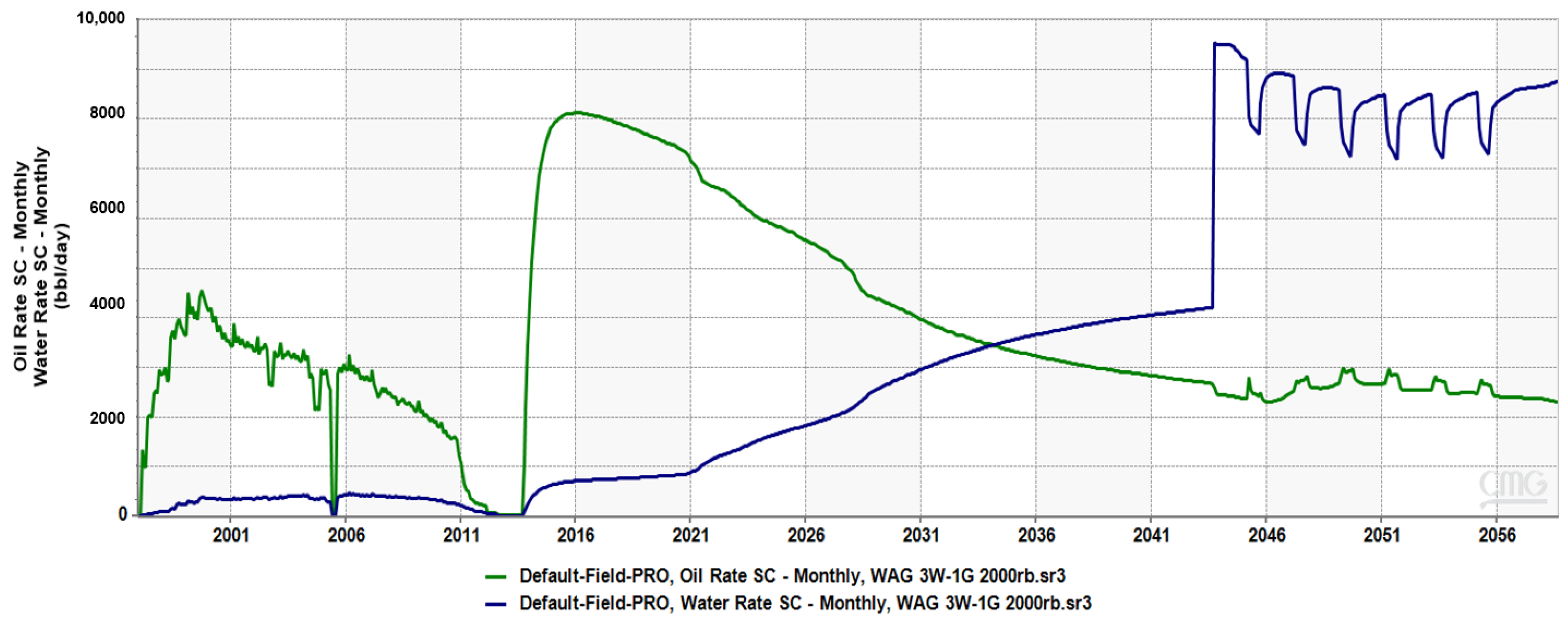
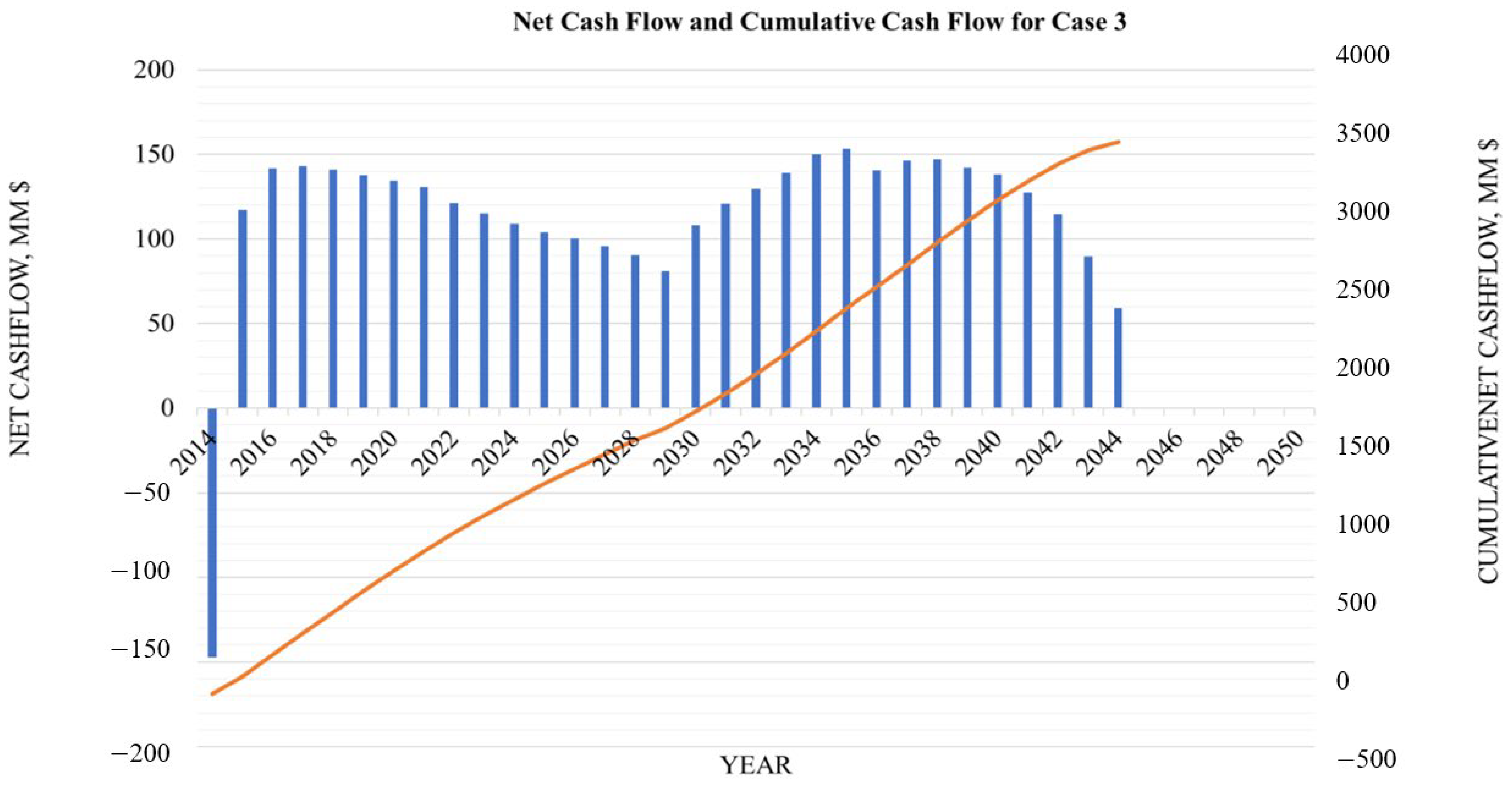
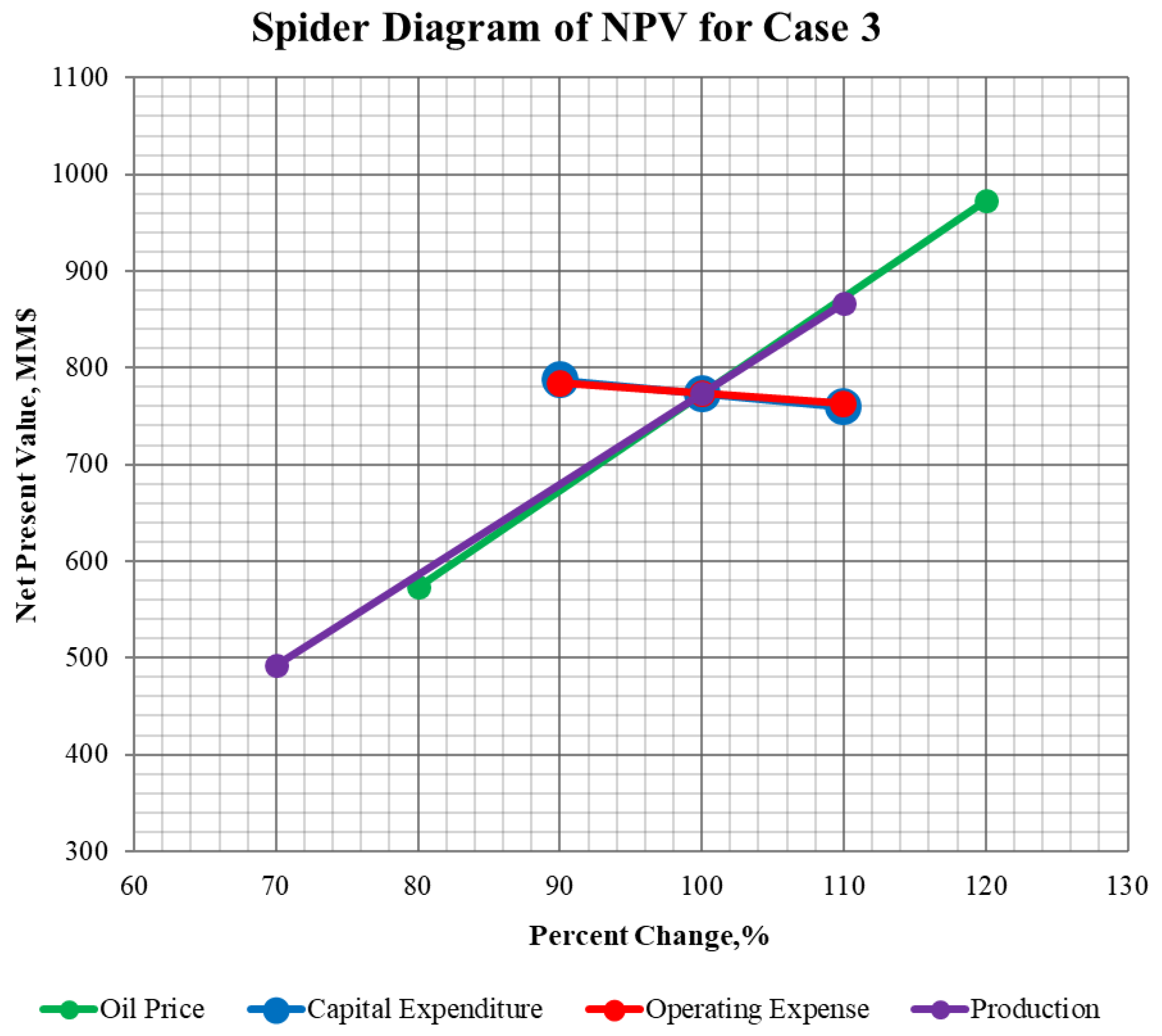

| Screening Criteria | |
|---|---|
| Oil and Reservoir Characteristics | Requirement |
| API oil gravity | >25 API |
| Viscosity | <10 cP |
| Depth | >2500 ft |
| Temperature | 100–170 F |
| Oil and Reservoir Characteristics | Value |
|---|---|
| API oil gravity | 32 API |
| Viscosity | 0.58 cP |
| Depth | 8000 ft |
| Temperature | 210 F |
| Properties | Value |
|---|---|
| Grid size, ft | |
| Average porosity, fraction | 0.216 |
| Average permeability, mD | 132 |
| Bubble point pressure, Pb (from Winprop fluid model), psia | 1851 |
| Initial reservoir pressure, psia | 4207 |
| Component | Mole Fraction |
|---|---|
| CO2 | 0.0015 |
| N2 to CH4 | 0.4206 |
| C2H6_IC4 | 0.1183 |
| NC4 to FC7 | 0.1109 |
| FC8_FC12 | 0.1526 |
| FC13_C19 | 0.1053 |
| FC20_30+ | 0.0908 |
| Total | 1 |
| Component | Mole Fraction |
|---|---|
| WOC upper reservoir | 8410 ft |
| WOC lower reservoir | 8395 ft |
| Aquifer thickness | 20 ft |
| Aquifer porosity | 0.23 |
| Aquifer permeability | 27 mD |
| Radius ratio | 2 |
| Initial aquifer pressure | 4370 psi |
| Case | Scenario | Period (Years) | Well | Cumulative Oil Recovery (MMSTB)/ Recovery Factor % | Remark (Mt: Metric ton) |
|---|---|---|---|---|---|
| 1 | Water flooding | 15 | 13, 9, 7, 5, 4, 2 | 50/ 19.6% | 4705 psi for injectors and 1950 psi for producers |
| 2 | Continuous CO2 after 15-year WF | 15 | 3, 8 | 59.7/ 23.4% | CO2 injection rate = 2–3 MMSCFD |
| 3 | Continuous CO2 after 15-year WF | 15 | 3, 8 | 97/ 38% | Set max BHP = 2700 psi CO2 injection rates: well 3 = 10–20 MMSCFD; well 8 = 8–15 MMSCFD. Total CO2 injected = 8.52 × 106 Mt; total produced = 1.69 × 106 Mt (recycled 20%, total purchased 6.83 × 106 Mt) |
| 4 | Water flooding | 30 | 13, 9, 7, 5, 4, 2 | 69/ 27% | 4705 psi for injectors and 1950 psi for producers |
| 5 | Continuous CO2 after 30-year WF | 15 | 3, 8 | 76.1/ 29.8% | CO2 injection rate = 2–3 MMSCFD. Total CO2 injected = 1.56 × 106 Mt; total produced = 1.04 × 105 (recycled 7%, total purchased 1.45 × 106 Mt) |
| 6 | Continuous CO2 after 30-year WF | 15 | 3, 8 | 97.3/ 38.1% | Set max BHP = 2700 psi; CO2 injection rates: well 3 = 7–17.5 MMSCFD Total CO2 injected = 1.03 × 107 Mt; produced = 4.11 × 106 Mt (recycled 40%, total purchased 6.19 × 106 Mt) |
| 7.1 | WAG after 30-year WF (1W:1G Cycle) | 15 | 4, 5, 6, 10 | 83.4/ 32.6% | BH injection: water = 2000 BBD; CO2 = 11,230 ft3/day (total of 4 wells SC = 14.4 MMSCFD; each well around 3.6 MMSCFD). Total CO2 injected/year = 1.95 × 106 Mt; total produced = 8.58 × 105 Mt (recycled 44%, total purchased 1.09 × 106 Mt) |
| 7.2 | WAG after 30-year WF (2W:1G Cycle) | 15 | 4, 5, 6, 10 | 83.2/ 32.6% | BH injection: water = 4000 BBD; CO2 = 11,230 ft3/day (total of 4 wells SC = 14.4 MMSCFD; each well around 3.6 MMSCFD). Total CO2 injected/year = 1.31 × 106 Mt; total produced = 5.26 × 105 Mt (recycled 40%, total purchased 7.81 × 105 Mt) |
| 7.3 | WAG after 30-year WF (3W:1G Cycle) | 15 | 4, 5, 6, 10 | 83.1/ 32.5% | BH injection: water = 6000 BBD; CO2 = 11,230 ft3/day (total of 4 wells SC = 14.4 MMSCFD; each well around 3.6 MMSCFD). Total CO2 injected/year = 8.90 × 105 Mt; total produced = 3.38 × 105 (recycled 38%, total purchased 5.53 × 105 Mt) |
| 7.4 | WAG after 30-year WF (1G:1W Cycle) | 15 | 4, 5, 6, 10 | 83.3/ 32.6% | BH injection: water = 2000 BBD; CO2 = 11,230 ft3/day (total of 4 wells SC = 14.4 MMSCFD; each well around 3.6 MMSCFD). CO2iInjected = 2.22 × 106 Mt; produced 1.01 × 106 Mt (recycled 45%, total purchased 1.21 × 106 Mt) |
| Parameters | Case 3 | Case 6 | Case 7.3 |
|---|---|---|---|
| CO2 recycling plant capital, USD/MM | 8.67 | 15.24 | 6.64 |
| Compressor cost, USD/MM | 78.12 | 71.62 | 42.50 |
| Cost of acquiring central batteries (Tanks), USD/MM | 0.02 | 0.02 | 0.02 |
| Cost of fluid-gathering system, USD/MM | 14.60 | 14.60 | 14.60 |
| Well injection pumps and wellheads, USD/MM | 2.10 | 2.80 | 2.80 |
| CO2 distribution line cost, USD/MM | 54.20 | 54.20 | 36.20 |
| Workovers, USD/MM | 0.07 | 0.07 | 0.07 |
| Total capex, USD/MM | 157.78 | 158.55 | 102.84 |
| Parameters | Case 3 | Case 6 | Case 7.3 |
|---|---|---|---|
| Surface Facility Maintenance, USD/MM | 330.32 | 335.12 | 272.27 |
| Electricity Costs, USD/MM | 85.58 | 70.74 | 9.79 |
| Water Costs, USD/MM | 1.04 | 11.03 | 12.90 |
| Water Treatment, USD/MM | 4.13 | 9.88 | 12.13 |
| CO2 Purchase, USD/MM | 252.23 | 156.35 | 22.35 |
| CO2 Treatment, USD/MM | 22.07 | 36.48 | 4.79 |
| Total OPEX, USD/MM | 695.38 | 619.60 | 334.23 |
| Parameters | Value |
|---|---|
| Surface facility maintenance (fixed daily rate), USD | 200,000 |
| Surface facility maintenance, USD/bbl | 4 |
| Water cost (contract), USD/bbl of water | 0.14 |
| Compression costs, USD/MMcf | 188.72 |
| Power costs, USD/HP | 2.88 |
| CO2 treatment costs, USD/MMcf | 700 |
| Water treatment costs, USD/bbl | 0.24 |
| CO2 cost (contract), USD/MMcf | 2000 |
| Oil price (@ global market), USD/bbl | 75 |
| Interest rate, % | 12 |
| Royalty, % | 15 |
| State tax, % | 3.75 |
| Federal tax, % | 18.5 |
| Parameter | Case 3 | Case 6 | Case 7.3 |
|---|---|---|---|
| Cumulative Production, MMSTB | 81.08 | 81.53 | 65.82 |
| Gross Revenue, USD/MM | 6081.00 | 6114.74 | 4936.26 |
| Total CAPEX, USD/MM | 157.78 | 158.55 | 102.84 |
| Total OPEX, USD/MM | 695.38 | 619.60 | 334.23 |
| Total Expenditure, USD/MM | 2556.34 | 2695.29 | 1862.79 |
| Net Cash Flow, USD/MM | 3524.66 | 3419.45 | 3073.47 |
| Net Present Value, USD/MM | 773.39 | 670.15 | 750.99 |
| IRR | 88% | 83% | 136% |
Disclaimer/Publisher’s Note: The statements, opinions and data contained in all publications are solely those of the individual author(s) and contributor(s) and not of MDPI and/or the editor(s). MDPI and/or the editor(s) disclaim responsibility for any injury to people or property resulting from any ideas, methods, instructions or products referred to in the content. |
© 2024 by the authors. Licensee MDPI, Basel, Switzerland. This article is an open access article distributed under the terms and conditions of the Creative Commons Attribution (CC BY) license (https://creativecommons.org/licenses/by/4.0/).
Share and Cite
Bui, D.; Nguyen, S.; Ampomah, W.; Acheampong, S.A.; Hama, A.; Amosu, A.; Koray, A.-M.; Appiah Kubi, E. A Comparison of Water Flooding and CO2-EOR Strategies for the Optimization of Oil Recovery: A Case Study of a Highly Heterogeneous Sandstone Formation. Gases 2025, 5, 1. https://doi.org/10.3390/gases5010001
Bui D, Nguyen S, Ampomah W, Acheampong SA, Hama A, Amosu A, Koray A-M, Appiah Kubi E. A Comparison of Water Flooding and CO2-EOR Strategies for the Optimization of Oil Recovery: A Case Study of a Highly Heterogeneous Sandstone Formation. Gases. 2025; 5(1):1. https://doi.org/10.3390/gases5010001
Chicago/Turabian StyleBui, Dung, Son Nguyen, William Ampomah, Samuel Appiah Acheampong, Anthony Hama, Adewale Amosu, Abdul-Muaizz Koray, and Emmanuel Appiah Kubi. 2025. "A Comparison of Water Flooding and CO2-EOR Strategies for the Optimization of Oil Recovery: A Case Study of a Highly Heterogeneous Sandstone Formation" Gases 5, no. 1: 1. https://doi.org/10.3390/gases5010001
APA StyleBui, D., Nguyen, S., Ampomah, W., Acheampong, S. A., Hama, A., Amosu, A., Koray, A.-M., & Appiah Kubi, E. (2025). A Comparison of Water Flooding and CO2-EOR Strategies for the Optimization of Oil Recovery: A Case Study of a Highly Heterogeneous Sandstone Formation. Gases, 5(1), 1. https://doi.org/10.3390/gases5010001







